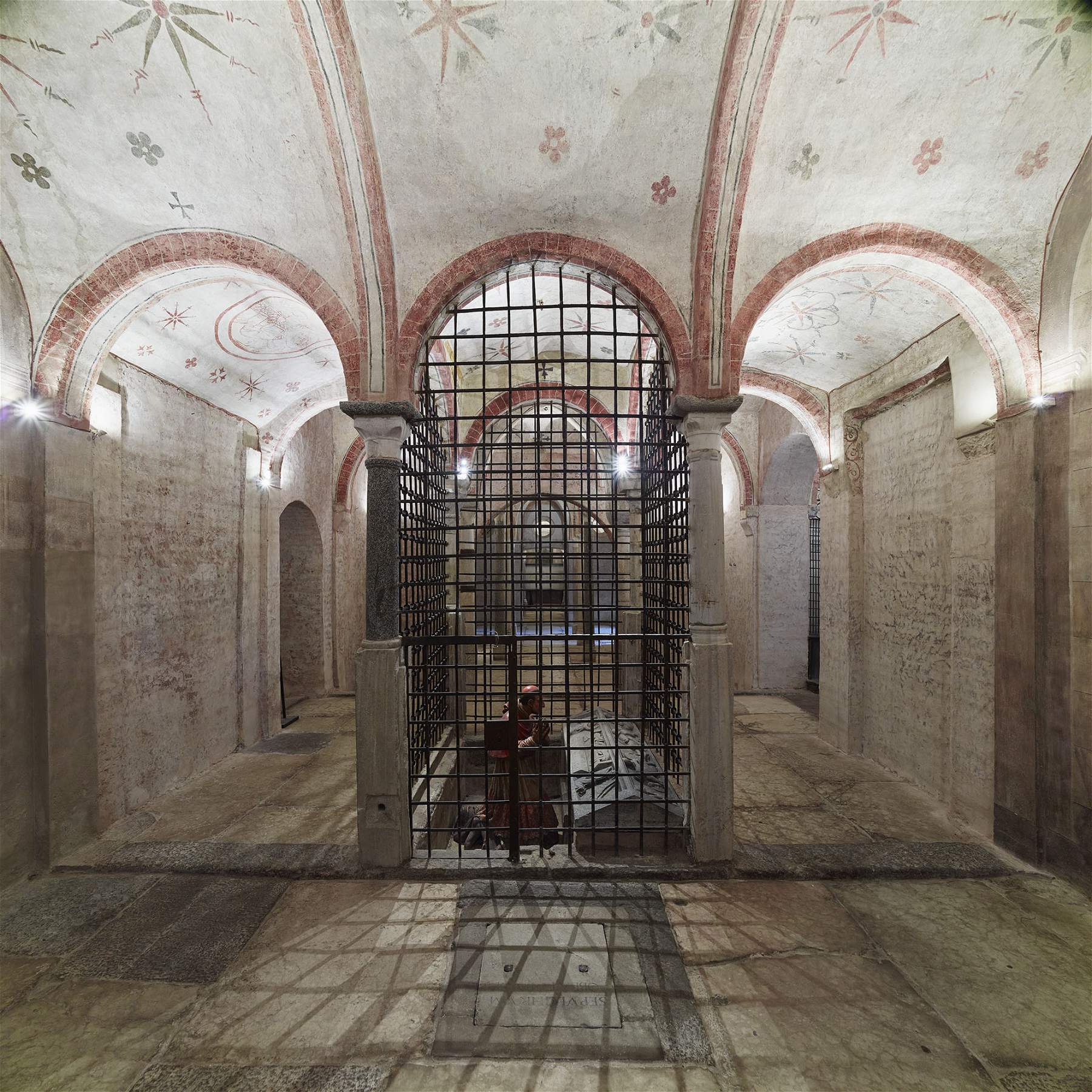Important discovery in Milan: medieval frescoes emerge from restoration of San Sepolcro church
The restoration of the underground church of San Sepolcro in Milan was completed a few days ago, allowing the Lombard capital to recover an important part of its artistic heritage. The work lasted a year, was conducted by the Superintendency of Milan thanks to a million euro grant from the Ministry of Cultural Heritage and Activities, with the Lombardy Regional Secretariat as the contracting station, and took place in close collaboration with the Veneranda Biblioteca Ambrosiana in Milan. Each stage of the restoration was supervised by the scientific committee headed by Antonella Ranaldi, superintendent of archaeology, fine arts and landscape for the metropolitan city of Milan, and composed of Monsignor Marco Ballarini, prefect of the Ambrosiana, Msgr. Alberto Rocca, director of the Pinacoteca Ambrosiana, Msgr. Marco Navoni, vice prefect of the Ambrosiana, Carlo Bertelli, Carlo Luigi Schiavi, University of Pavia, and Andrea Spiriti, University of Insubria.
The church of San Sepolcro is one of the oldest in Milan: the earliest records of the building date back to the 11th century, although the dedication to the Holy Sepulchre is from the following century (with contemporary remodeling of the church to give it the appearance of the Holy Sepulchre of Jerusalem). Repeatedly renovated and altered over the centuries, it currently has a 19th-century neo-Romanesque exterior: the oldest core is the crypt (or underground church: it is the oldest underground church in the city), which has been the subject of restoration.
The restoration led to an important discovery: in fact, the interventions brought to light new medieval paintings. In particular, frescoes and decorations such as the ornamental cycle of stars and plant elements that adorns the vaults of the presbytery have emerged: these are paintings that can be dated to the late 13th century. This surface constitutes an important motif, recurring especially in monastic architecture of the 13th and 14th centuries, here characterized by unprecedented freshness, variety and richness of form. Phytomorphic stars, with palmettes and candle-flame rays, expand to occupy the space of the vaults, while in other areas they extend more regularly in a carpet-like fashion.
But that’s not all: next to the sacellum of the Holy Sepulchre, the image of theAngel (perhaps a representation of the Archangel Michael), enclosed in a red monochrome tondo, has reappeared on the vault to the left. The Angel announces the Resurrection, and is linked to the rites of lighting the candle at Easter vigils and in the processions that departed from St. Sepulchre on their way to the cathedral. Also restored were the frescoes, which had become almost invisible due to deposits of surface salts from heavy moisture and condensation, including the crucifixions (one in the descending staircase, the other 14th-century in the chancel), the three standing figures of Magdalene, John the Baptist and Helena, the mother of Constantine (or perhaps St. Catherine ofAlexandria) and The Supper in Simon’s House in the left wing of the chancel, the 16th-century frescoes of Our Lady of Loreto and Our Lady and Saints Roch and John the Baptist in the atrium, and the 17th-century stuccoes and decorations in the apse depicting the instruments of the Passion.
What’s more, georadar surveys were carried out to explore the subsoil; the composition of the materials (stucco, plaster, fictile and stone elements), that of the cocciopesto subfloors, and the stratigraphy of the masonry was analyzed. The studies conducted during the restoration will be collected in a volume, published soon by Silvana Editoriale.
“We are grateful to the Ministry of Cultural and Environmental Heritage,” says Marco Ballarini, Prefect of the Veneranda Biblioteca Ambrosiana, “for giving us the opportunity to return this jewel of Romanesque art to the city and to all those who will pass through Milan for so many reasons. Gratitude extends, of course, to Superintendent Antonella Ranaldi, architect Pedrini and all those who collaborated in this ’resurrection.’ The other feeling is perhaps more complex and almost borders on fear, because the church of San Sepolcro is not only rich in art, but is laden with a spiritual heritage that must not be lost.”
“Today,” says Milan Mayor Giuseppe Sala, “reopens a place that is highly symbolic and exciting for anyone who visits it. With the restoration of the underground Church of San Sepolcro all citizens will be able to get to know a timeless treasure. For this reason, I thank the Veneranda Biblioteca Ambrosiana, the Superintendence of Milan and the Ministry of Cultural Heritage and Activities. The frescoes and extraordinary decorations brought to light with the work not only add to the narrative of ancient Milan, but also confirm, once again, how much ours is a city of art, history and culture.”
“The oldest underground church in Milan,” explains Stefano Bruno Galli, Lombardy Region’s Councillor for Autonomy and Culture, “born in the aftermath of the year one thousand, comes back to light. Careful restoration work has unearthed authentic art treasures. I am pleased that the people of Milan, and all Lombardy, are being given back a place so emblematic of their history. A nucleus of Christian devotion, built more than three hundred years before the birth of the Duomo, which has been considered for centuries the real heart of Milan, umbilicus civitatis.”
Pictured: the church of San Sepolcro after restoration.
 |
| Important discovery in Milan: medieval frescoes emerge from restoration of San Sepolcro church |
Warning: the translation into English of the original Italian article was created using automatic tools. We undertake to review all articles, but we do not guarantee the total absence of inaccuracies in the translation due to the program. You can find the original by clicking on the ITA button. If you find any mistake,please contact us.





























